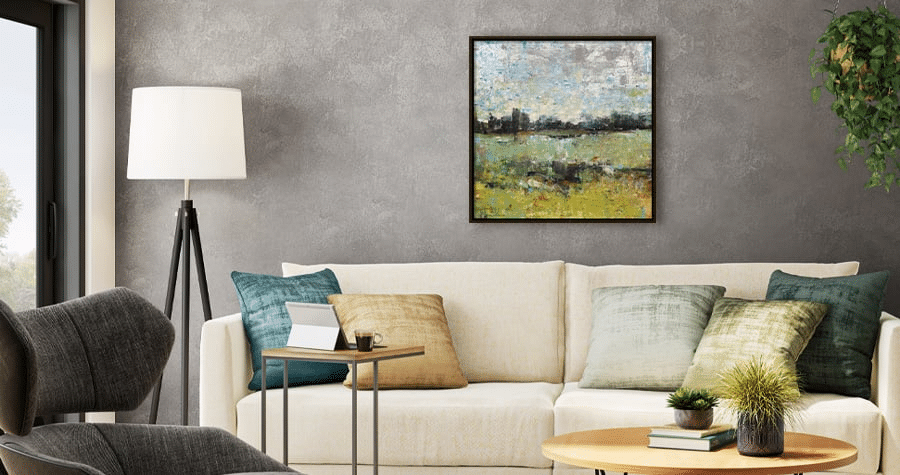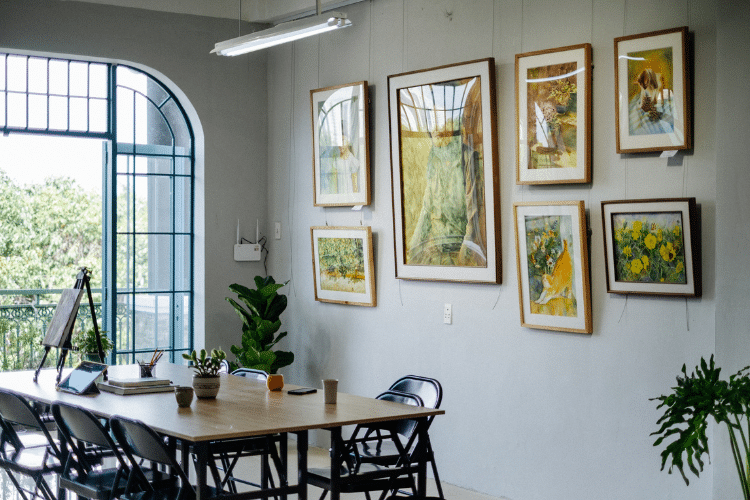Large-format art actively shapes how people move through and experience your rooms. When placed strategically, oversized artwork creates visual pathways that guide the eye and influence foot traffic patterns in surprisingly effective ways.
Most homeowners underestimate the power of scale in interior design, missing opportunities to use substantial pieces as architectural elements that define space and improve functionality. Understanding how to leverage large art as a design tool transforms your approach to room layout, creating more intentional and cohesive spaces that feel professionally designed and naturally inviting.
Understanding Visual Weight and Movement
Large-format art carries significant visual weight that naturally draws attention and creates focal points within a room. This visual gravity affects how people perceive and navigate spaces, pulling the eye toward specific areas and establishing hierarchy in your design. When you understand this principle, you can use oversized pieces to direct attention exactly where you want it.
Key concepts to consider:
- Visual weight anchors a space and gives it a clear starting point
- Bold colors and high contrast increase the pulling power of artwork
- Placement height affects whether art draws eyes up or keeps them level
- Scale relative to furniture determines whether art dominates or complements
The interaction between visual weight and physical movement creates what designers call “flow”—the natural path people take through a space.
Positioning Art as Wayfinding Tools
Think of large-format art as signposts that guide people through your home. Placing a substantial piece at the end of a hallway, for example, draws people forward and makes the space feel less narrow. In open-concept layouts, strategic art placement helps define different zones without requiring physical barriers.
Effective wayfinding strategies:
- Position art at natural transition points between spaces
- Use pieces to highlight entryways or passages you want to emphasize
- Place art where sightlines converge from multiple angles
- Create visual destinations that encourage movement through the room
This approach works especially well in homes where rooms flow into each other and you need subtle ways to organize the space.
Selecting the Right Scale for Your Space

Choosing appropriately sized art requires careful consideration of your room dimensions and ceiling height. A piece that’s too small gets lost and fails to create impact, while properly scaled art commands attention and establishes presence. For most living spaces, art should occupy roughly two-thirds to three-quarters of the available wall space above furniture.
Scale selection guidelines:
- Measure your wall space before shopping to avoid guesswork
- Consider ceiling height—taller rooms can handle more vertical pieces
- Leave adequate breathing room around the artwork
- Account for furniture dimensions when determining placement height
Quality canvas art from sources like experts at https://thegoatwallart.com/ comes in various sizes, making it easier to find pieces that match your specific spatial requirements.
Creating Sightlines and Focal Points
Every room needs a clear focal point that grounds the design and gives the eye somewhere to rest. Large format art serves this purpose beautifully, establishing a visual anchor that organizes everything else in the room. When positioned thoughtfully, these pieces create sightlines that guide how people view and move through the space.
Establishing effective focal points:
- Place art where it’s visible from main entry points
- Position pieces to be the first thing noticed when entering
- Use art to draw attention away from less attractive features
- Ensure your focal point doesn’t compete with architectural elements
Once you establish a strong focal point, arrange furniture and accessories to support rather than fight against it.
Balancing Multiple Spaces in Open Layouts
Open-concept homes present unique challenges because traditional walls don’t define separate areas. Large format art becomes crucial in these spaces, helping to visually separate dining areas from living spaces or create a sense of definition in expansive rooms. The key is using art to suggest boundaries without creating hard divisions.
Strategies for open layouts:
- Use coordinating but different pieces to distinguish zones
- Maintain consistent style or color palette for cohesion
- Vary the scale slightly between areas to create subtle separation
- Position art to be viewed from multiple angles throughout the space
This approach maintains the open feeling while giving each area its own identity and purpose.
Directing Eye Movement With Color and Composition
The colors and composition within your large-format art influence how quickly or slowly the eye moves across it, which in turn affects room flow. Pieces with strong horizontal lines create a sense of calm and width, while vertical compositions draw the eye upward and make ceilings feel higher. Dynamic, diagonal compositions create energy and movement.
Color and composition considerations:
- Warm colors advance and feel energizing, cool colors recede and calm
- High contrast creates drama and quick eye movement
- Subtle tonal variations encourage slower, more contemplative viewing
- Repeating elements create a rhythm that guides the eye predictably
Match the energy of your art to the function of the room—active spaces benefit from dynamic pieces while restrooms need calming compositions.
Layering Art With Architectural Features
Large-format art works best when it complements rather than compete with your home’s architecture. Use substantial pieces to highlight beautiful features like fireplaces, built-in shelving, or interesting windows. Conversely, strategic art placement can downplay awkward architectural elements by redirecting attention.
Architectural integration tips:
- Center art above mantels or consoles for traditional symmetry
- Offset pieces slightly in modern spaces for contemporary appeal
- Use art to balance asymmetrical architectural features
- Consider how natural light affects art visibility throughout the day
The relationship between art and architecture should feel intentional, creating harmony that enhances both elements.
Maintaining Cohesion Across Connected Rooms
When rooms connect visually—through doorways, open passages, or sightlines—your art choices in each space affect the overall flow of your home. Large-format pieces become even more important because they’re often visible from adjacent rooms. Creating cohesion doesn’t mean everything must match, but there should be intentional connections.
Achieving visual cohesion:
- Repeat one or two key colors across adjacent spaces
- Maintain consistent framing style or finish throughout
- Vary subjects while keeping similar artistic styles
- Consider what’s visible from each room when selecting placement
This creates a sense of journey as you move through your home, with each space feeling distinct yet connected.
Conclusion
Large-format art serves as a powerful design tool that extends far beyond simple decoration. When you approach these pieces as elements that actively shape room flow and guide movement, you unlock their full potential to transform your spaces. The strategic placement of substantial artwork creates visual pathways, establishes clear focal points, and helps define areas within open layouts.
Start by identifying the natural flow patterns in your home and consider where large art could enhance or redirect that movement. Remember that effective use of scale, color, and placement makes the difference between art that simply hangs on walls and art that fundamentally improves how your home functions and feels.

